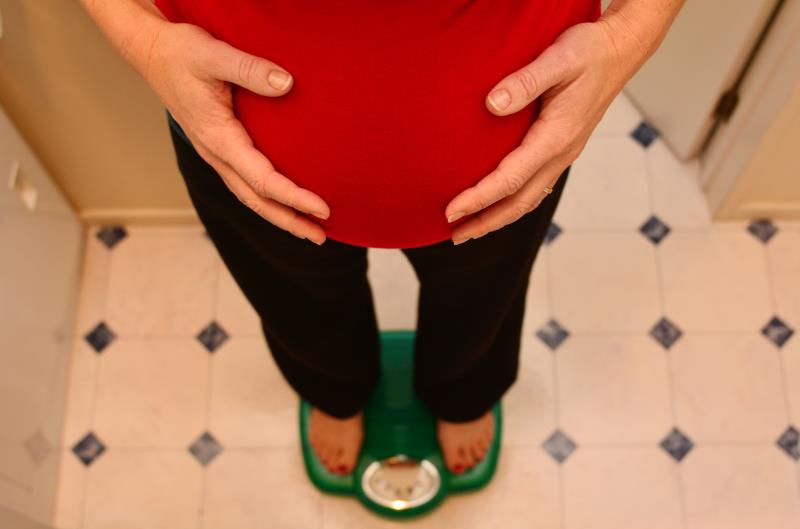Obesity tied to multiple negative pregnancy and birth outcomes





Women who are obese may have a host of pregnancy-related negative outcomes including pre-eclampsia and large for gestational age (LGA) infants, according to several studies from ACOG 2020.
In one study, data from the University of Washington medical system was used to identify 5,972 births that occurred in 2009–2018. Of these, pre-eclampsia occurred in 17.1 percent (n=1,024).
Compared with women who did not experience pre-eclampsia, those who did had a higher body weight (81.6 vs 70.5 kg) and BMI (30.25 vs 26.22 kg/m2; p<0.001 for both). There was a twofold risk of pre-eclampsia among women with obesity than non-obese women (27.5 percent vs 11.4 percent). [ACOG 2020, abstract 01D]
Women who developed pre-eclampsia had elevated blood pressure levels at 6–9 and 0–6 months preconception, and within the first and second trimesters of pregnancy. The risk of pre-eclampsia was greater among women with pre-existing hypertension vs without (77.3 percent vs 0.6 percent; p<0.001).
Women with pre-eclampsia had a greater risk of having preterm deliveries than women without pre-eclampsia (28.0 percent vs 13.2 percent; p<0.001).
“Obesity and elevated blood pressure as long as 9 months preconception and during early pregnancy were associated with pre-eclampsia [as was] a diagnosis of hypertension pre-pregnancy,” said the researchers.
Another retrospective study comprising 687 women with singleton pregnancies who delivered at the University of Texas Health San Antonio, Texas, US, in 2013–2015, demonstrated a link between increasing BMI levels and pre-eclampsia. In this study, the incidence of pre-eclampsia was 9.25, 10.61, 15.58, 15.79, and 20.0 percent in women with BMI of 18–24.9, 25–29.9, 30.0–34.9, 35.0–39.9, and ≥40 kg/m2, respectively (p=0.0795). [ACOG 2020, abstract 28D]
There was a significant association between BMI and pre-eclampsia when comparing women with and without obesity (≥30 vs <30 kg/m2; p=0.0127), though there was no link between pre-eclampsia risk and weight gained during pregnancy (p=0.912).
Increasing BMI was also significantly linked to the risk of pregestational diabetes (p<0.0001) and demonstrated a trend toward an increased risk of gestational diabetes (GD).
“Obesity appears to be more important than weight gained during pregnancy in the development of pre-eclampsia and GD,” said the authors. “This highlights the importance of pre-conception weight reduction and optimization for the prevention of morbidity in pregnancy.”
Another study analysed 325 women with a BMI >35 kg/m2 who presented at a tertiary academic institution between 2016 and 2019. [ACOG 2020, abstract 29D]
Diabetes status did not affect infant birth weight in this population. However, LGA infants were more common among women with diabetes than non-diabetics (17 percent vs 7 percent; p=0.024).
Total weight gain during pregnancy and pre-pregnancy BMI were both associated with an elevated risk of LGA infants (odds ratio [OR], 1.03; p=0.016 and OR, 1.08; p=0.018, respectively). The presence of diabetes (relative risk [RR], 146; p=0.019), total weight gain (RR, 4; p=0.015), and gestational age (RR, 197; p<0.001) were associated with neonatal birth weight.
In contrast, another prospective study of 405 women with obesity, of whom 256 and 68 had excessive and adequate weight gain, respectively, showed no association between excessive weight gain during pregnancy and likelihood of LGA infants (p=0.35). [ACOG 2020, abstract 33D]
In this study, excessive weight gain was also not tied to GD (p=0.12), a composite of adverse neonatal outcomes (p=0.75), gestational hypertension (p=0.87), pre-eclampsia (p=0.68), preterm delivery (p=0.91), or small for gestational age (p=0.21), regardless of obesity class (BMI 30–34.9, 35–39.9, or ≥40 kg/m2).